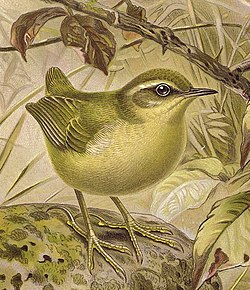| Xenicus | |
|---|---|
 | |
| A South Island wren. | |
| Scientific classification | |
| Kingdom: | Animalia |
| Phylum: | Chordata |
| Class: | Aves |
| Order: | Passeriformes |
| Family: | Acanthisittidae |
| Genus: | Xenicus G.R. Gray, 1855 |
| Type species | |
| Motacilla longipes [1] Gmelin, 1789 | |
| Synonyms | |
Pachyplichas (Millener, 1988) | |
Xenicus is a genus of birds in the family Acanthisittidae . It contains New Zealand wrens.
